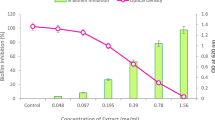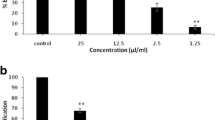Abstract
The Kewda essential oil (KEO) extracted from Pandanus odorifer male flower was evaluated for its phytochemical profiles, antimicrobial and anti-biofilm activities against Staphylococcus aureus and Klebsiella pneumoniae and their reference strains, MTCC 740 and MTCC 109 respectively. As evident from GC-MS analysis, the phytochemical profiles revealed the presence of 2-phenyl ethyl methyl ether (PEME) and Terpinen-4-ol as prominent secondary metabolites. The MIC of KEO was 5% (v/v) against all the test bacteria. The KEO exhibited strong antibacterial and anti-biofilm activities against test bacteria. A significant reduction in the biofilm production was observed with an inhibition of 67.51 ± 1.29% and 61.17 ± 3.75% against K. pneumoniae and 71.76 ± 4.56% and 59.3 ± 6.24% against S. aureus. The light and fluorescence microscopic analysis confirmed a significant decrease in the density and thickness of the biofilm matrix against both the clinical and reference strains when treated with sub-MIC of KEO.




Similar content being viewed by others
Abbreviations
- CLSI:
-
Clinical and Laboratory Standards Institute
- CRA:
-
Congo Red Agar
- EPS:
-
Extracellular Polymeric Substances
- ESKAPE:
-
Enterococcus faecium, Staphylococcus aureus, Klebsiella pneumoniae, Acinetobacter baumannii, Pseudomonas aeruginosa and Enterobacter spp.
- FT-IR:
-
Fourier Transform Infrared
- GC-MS:
-
Gas Chromatography-Mass Spectroscopy
- IMTECH:
-
Institute of Microbial Technology
- KEO:
-
Kewda Essential Oil
- KBr:
-
Potassium bromide
- MHB:
-
Mueller Hinton Broth
- BHI:
-
Brain Heart Infusion
- MIC:
-
Minimum Inhibitory Concentration
- PBS:
-
Phosphate Buffer Solution
- MTCC:
-
Microbial Type Culture Collection
- NIST:
-
National Institute of Standards and Technology
- PEME:
-
2-phenyl ethyl methyl ether
- TTC:
-
2, 3, 5-triphenyltetrazolium chloride
- VIMSAR:
-
Veer Surendra Sai Institute of Medical Sciences and Research
References
Abd Wahab NZ, Jaafar NSA, Ismail SB (2022) Evaluation of antibacterial activity of essential oil of Melaleuca cajuputi Powell. J Pure Appl Microbiol 16(1):549–556. https://doi.org/10.22207/JPAN.16.1.52
Adkar PP, Bhaskar VH (2014) Pandanus odoratissimus (Kewda): a review on ethnopharmacology, phytochemistry, and nutritional aspects. Adv Pharmacol Sci 2014:120895. https://doi.org/10.1155/2014/120895
Agatonovic-Kustrin S, Ristivojevic P, Gegechkori V, Litvinova TM, Morton DW (2020) Essential oil quality and purity evaluation via FT-IR spectroscopy and pattern recognition techniques. Appl Sci 10(20):7294. https://doi.org/10.3390/app10207294
Bazargani MM, Rohloff J (2016) Antibiofilm activity of essential oils and plant extracts against Staphylococcus aureus and Escherichia coli biofilms. Food Cont 61:156–164. https://doi.org/10.1016/j.foodcont.2015.09.036
Cannas S, Molicotti P, Usai D, Maxia A, Zanetti S (2014) Antifungal, anti-biofilm and adhesion activity of the essential oil of Myrtus communis L. against Candida species. Nat Prod Res 28(23):2173–2177. https://doi.org/10.1080/14786419.2014.925892
Cebi N, Arici M, Sagdic O (2021) The famous turkish rose essential oil: characterization and authenticity monitoring by FTIR, Raman and G.C.–M.S. techniques combined with chemometrics”. Food Chem 354:129495. https://doi.org/10.1016/j.foodchem.12949
Cheruvanachari P, Pattnaik S, Mishra M, Pragyandipta P, Naik PK (2022) Terpinen-4-ol, an active constituent of kewda essential oil, mitigates biofilm forming ability of multidrug resistant Staphylococcus aureus and Klebsiella pneumoniae. J Biol Active Prod Nature 12(5):406–420. https://doi.org/10.1080/22311866.2022.2154264
Chhibber S, Gondil VS, Sharma S, Kumar M, Wangoo N, Sharma RK (2017) A novel approach for combating Klebsiella pneumoniae biofilm using histidine functionalized silver nanoparticles. Front Microbiol 8:1104. https://doi.org/10.3389/fmicb.2017.01104
Cordeiro L, Figueiredo P, Souza H, Sousa A, Andrade-Junior F, Medeiros D et al (2020) Terpinen-4-ol as an antibacterial and Antibiofilm Agent against Staphylococcus aureus. Int J Mol Sci 21(12):4531. https://doi.org/10.3390/ijms21124531
Das A, Dey S, Sahoo RK, Sahoo S, Subudhi E (2019) Antibiofilm and antibacterial activity of essential oil bearing Zingiber officinale Rosc. (ginger) rhizome against multi-drug resistant isolates. J Essent Oil Bearing Plants 22(4):1163–1171. https://doi.org/10.1080/0972060X.2019.1683080
Ghazal TSA, Schelz Z, Vidács L, Szemerédi N, Veres K, Spengler G, Hohmann J (2022) Antimicrobial, Multidrug Resistance reversal and biofilm formation inhibitory effect of Origanum majorana extracts, essential oil and Monoterpenes. Plants 11(11):1432. https://doi.org/10.3390/plants11111432
Heydorn A, Nielsen AT, Hentzer M, Sternberg C, Givskov M, Ersbøll BK, Molin S (2000) Quantification of biofilm structures by the novel computer program COMSTAT. Microbiology 146(10):2395–2407. https://doi.org/10.1099/00221287-146-10-2395
Kang J, Jin W, Wang J, Sun Y, Wu X, Liu L (2019) Antibacterial and anti-biofilm activities of peppermint essential oil against Staphylococcus aureus. LWT 101:639–645. https://doi.org/10.1016/j.lwt.2018.11.093
Khaleel C, Tabanca N, Buchbauer G (2018) α-Terpineol, a natural monoterpene: a review of its biological properties. Open Chem 16(1):349–361. https://doi.org/10.1515/chem-2018-0040
Kim YG, Lee JH, Gwon G, Kim SI, Park JG, Lee J (2016) Essential oils and eugenols inhibit biofilm formation and the virulence of Escherichia coli O157: H7. Sci Rep 6:36377. https://doi.org/10.1038/srep36377
Kim YG, Lee JH, Kim S, Baek KH, Lee J (2015) Cinnamon bark oil and its components inhibit biofilm formation and toxin production. Int J Food Microbiol 195:30–39. https://doi.org/10.1016/j.ijfoodmicro.2014.11.028
Man A, Santacroce L, Jacob R, Mare A, Man L (2019) Antimicrobial activity of six essential oils against a group of human pathogens: a comparative study. Pathogens 8:15. https://doi.org/10.3390/pathogens8010015
Nasim N, Behera JK, Sandeep IS, RamaRao VV, Kar B, Mishra A, Mohanty S (2018) Phytochemical analysis of flower from Pandanus odorifer (Forssk.) Kuntze for industrial application. Nat Prod Res. 32(20): 2494–2497. https://doi.org/10.1080/14786419.2017.1422184
Negreiros MDO, Pawlowski Â, Zini CA, Soares GLG, Motta ADS, Frazzon APG (2016) Antimicrobial and antibiofilm activity of Baccharis psiadioides essential oil against antibiotic-resistant Enterococcus faecalis strains. Pharmaceut Biol 54(12):3272–3279. https://doi.org/10.1080/13880209.2016.1223700
Packiavathy IASV, Priya S, Pandian SK, Ravi AV (2014) Inhibition of biofilm development of uropathogens by curcumin-An anti-quorum sensing agent from Curcuma longa. Food Chem 148:453–460. https://doi.org/10.1016/j.foodchem.2012.08.002
Pontes EKU, Melo HM, Nogueira JWA, Firmino NCS, de Carvalho MG, Catunda Júnior FEA, Cavalcante TA (2019) Antibiofilm activity of the essential oil of citronella (Cymbopogon nardus) and its major component, geraniol, on the bacterial biofilms of Staphylococcus aureus. Food Sci Biotechnol 28(3):633–639. https://doi.org/10.1007/s10068-018-0502-2
Purkait S, Bhattacharya A, Bag A, Chattopadhyay RR (2020) Synergistic antibacterial, antifungal and antioxidant efficacy of cinnamon and clove essential oils in combination. Arch Microbiol 202(6):1439–1448. https://doi.org/10.1007/s00203-020-01858-3
Raina VK, Kumar A, Srivastava SK, Syamsundar KV, Kahol AP (2004) Essential oil composition of ‘kewda’ (Pandanus odoratissmus) from India. Flavour Fragr J 19:434–436. https://doi.org/10.1002/ffj.1331
Rubini D, Banu SF, Nisha P, Murugan R, Thamotharan S, Percino MJ, Subramani P, Nithyanand P (2018) Essential oils from unexplored aromatic plants quench biofilm formation and virulence of Methicillin Resistant Staphylococcus aureus. Microb Pathog 122:162–173. https://doi.org/10.1016/j.micpath.2018.06.028
Singh S, Singh SK, Chowdhury I, Singh R (2017) Understanding the mechanism of bacterial biofilms resistance to antimicrobial agents. Open Microbiol J 11:53. https://doi.org/10.2174/1874285801711010053
Song X, Xia YX, He ZD, Zhang HJ (2018) A review of natural products with anti-biofilm activity. Curr Org Chem 22(8):789–817. https://doi.org/10.2174/1385272821666170620110041
Wu S, Liu G, Jin W, Xiu P, Sun C (2016) Antibiofilm and anti-infective of a marine bacterial polysachharide against Pseudomonas aeruginosa. Front Microbiol 7:102. https://doi.org/10.3389/fmicb.2016.00102
Acknowledgements
We would like to acknowledge OHEPEE, Govt. of Odisha, through the World Bank initiative for providing financial support. The author, Subhaswaraj Pattnaik also gratefully acknowledges the Science and Engineering Board (SERB), Department of Science and Technology (DST), Govt. of India for the award of National Post-Doctoral Fellowship (NPDF) programme (Ref. Number: PDF/2021/001260).
Author information
Authors and Affiliations
Contributions
Priya Cheruvanachari: Methodology, Data analyses, Original draft preparation. Monika Mishra: Design of the study, Methodology, Data analysis, Original draft preparation, Writing - Review and editing. Subhaswaraj Pattnaik: Conceptualization, Design of the study, Methodology, Data analysis, Original draft preparation, Writing - Review and editing, Funding acquisition. Pradeep Kumar Naik: Conceptualization, Design of the study, Writing - Review and Editing, Funding acquisition.
Corresponding author
Ethics declarations
Competing Interest
The authors declare that no potential conflict of interest.
Ethical approval statement
No ethical approval is required for the present study.
Additional information
Publisher’s Note
Springer Nature remains neutral with regard to jurisdictional claims in published maps and institutional affiliations.
Rights and permissions
Springer Nature or its licensor (e.g. a society or other partner) holds exclusive rights to this article under a publishing agreement with the author(s) or other rightsholder(s); author self-archiving of the accepted manuscript version of this article is solely governed by the terms of such publishing agreement and applicable law.
About this article
Cite this article
Cheruvanachari, P., Mishra, M., Pattnaik, S. et al. Determination of antibacterial and anti-biofilm potential of Kewda essential oil against Staphylococcus aureus and Klebsiella pneumoniae. Biologia 78, 2253–2260 (2023). https://doi.org/10.1007/s11756-023-01360-3
Received:
Accepted:
Published:
Issue Date:
DOI: https://doi.org/10.1007/s11756-023-01360-3




